Rural people in Canada are sicker, die sooner, and experience severe health-related challenges, such as limited or no health care, isolation, poverty, disempowerment, and limited health knowledge, compared with other Canadians1-3. In addition, rural communities are aging communities; by 2021 one in four seniors will live in a rural setting4. Thus, not surprisingly, over the next 10 years rural settings in Canada, perhaps even more than urban settings, can expect to experience rising rates of chronic diseases such as obesity, diabetes, heart disease, stroke, tobacco-related illnesses, and environmental illnesses1,5.
Rural nurses provide many and diverse services, including those related to acute and chronic care, health promotion, disease and injury prevention, home care and rehabilitation services, health protection, health surveillance, population health assessment, and emergency preparedness6-8. Rural nurses work in a variety of settings, including hospitals, communities, homes, and schools. In more isolated or small communities they are often the only healthcare professionals9. Thus, the work of rural nurses - because of its diverse and demanding nature, in isolated physical environments that are often very challenging, and in work situations with limited resources and where they often work alone - requires the brightest and the best practitioners10 who are committed, resourceful, and multi-skilled generalists11. Enhanced student understanding and appreciation of rural nursing practice will certainly help them to be the brightest and best practitioners that are so desperately needed in underserved rural settings.
Nonetheless, rural areas are struggling to attract and retain essential nursing services5,12,13. A decreasing nursing workforce, healthcare reform that has centralized health care to urban settings and eliminated many rural services, and rural depopulation with associated limited rural political voice and power have contributed to weakened rural health care1,12,14. The minimal selection by nursing students of rural sites as locations for nursing practice post-graduation also contributes to problematic recruitment and retention of rural nurses15. Students may not be exposed adequately or at all to rural health and rural nursing practice within their nursing programs, and may thus have limited understanding and appreciation of the challenges, facilitators, and benefits of such practice15. For example, challenges such as limited resources and isolation and facilitators such as broadened scope of practice and familiarity with the community can affect the autonomy, nature, and effectiveness of rural nursing practice8,9,11. As a consequence, after graduation nursing students may choose to practice in the more comfortable and familiar urban environments in which they received most or all of their nursing education. However, the recruitment and retention of rural nurses may be facilitated if their nursing education has adequately prepared them for a satisfying and realistic rural practice.
The Government of Ontario, the province where this study was conducted, has recently highlighted the priority need for equity of access to health and health care in rural contexts16,17. Rural contexts are defined in Ontario as communities 'with a population of less than 30 000 that are greater than 30 min away in travel time from a community with a population of more than 30 000'(p4)18. Enhancing student understanding about the nature of rural communities, rural nursing, and rural health issues could significantly enhance recruitment and retention of rural nurses, with concomitant benefits for the health of individuals, families, and communities. Accordingly, the study reported here seeks to facilitate student understanding of rural nursing practice, with the goal to generate interest and knowledge such that students might select and remain in a rural practice location after graduation.
Theoretical framework
This study was guided by adult learning principles19 and experiential learning theory20 that suggest that understanding and attitude formation can be affected by meaningful learning experiences outside the classroom. Extra-classroom experiences expose adult students to on-site locations and situations that both enrich and broaden theoretical content addressed in class and that facilitate reflective thinking about the relationship of theory to practice and the nature of practice situations. The students in this study had the opportunity to select the rural locations and situations to photograph and upon which to reflect, thereby facilitating learning that had particular meaning to them.
Photovoice, an innovative research method that was originally designed for research with rural women21, provides study participants with the opportunity to use cameras to document and reflect upon information relevant to rural communities. Photovoice photographs can act as a catalyst for discussion, visually document difficult to describe situations (such as rural isolation), and promote empathy and understanding (as in the saying 'A picture is worth a thousand words') that foster learning and social change22,23. Students experienced all of these method effects as they travelled to rural areas to take photographs and documented these images in their assignments, discussed them in class and in written reflections, and revealed that their valuing of rural health and rural nursing had been fostered as a result of this experience.
In this study photovoice provided a stimulating and creative way for nursing and health sciences students to get into the rural field, so to speak, to obtain and reflect on rural nursing practice's challenges and facilitators. The objectives of the study were to: (i) facilitate undergraduate nursing and health sciences students' understanding of the facilitators and challenges of rural nursing practice; (ii) stimulate student interest and awareness of the facilitators and challenges to rural nursing practice; and (iii) explore the fit and utility of photovoice with this population and topic of study.
Setting and sample
Prior to beginning the study ethical approval was received from the University of Western Ontario. Thirty-eight third and fourth year nursing and health sciences students who enrolled in the third-year elective classroom course 'Rural Nursing', for which the first author was professor, participated in this research activity. The nursing students were enrolled in a four year Bachelor of Science in Nursing degree program, and the health sciences students were studying in a degree program that more generally addresses aspects of health and health care. As this was an elective course, nursing and health sciences students were eligible to enroll; inclusion of these students was viewed as a way to enrich the course with interprofessional perspectives, as well as an opportunity to interest non-nursing students in a rural career. Most of the students (n=33) were nursing students; five additional students were enrolled in the bachelor of health sciences program. For the nursing students, this was the first and only course in their nursing degree program that focused on rural health; for the health sciences students, this course was their first and only in-depth study of rural nursing. All participants were female and ranged in age from early 20s to mid-40s with most being in their early 20s. Two students did not consent to their data being included in the dissemination of the research, thus the data of 36 students are provided in this report.
Data collection
Students were instructed to travel to rural locations of their choice and use their own cameras to take good quality photographs of challenges to and facilitators of rural nursing practice. They were then to select two photos that represented challenges to rural nursing practice and two photos that represented facilitators of rural nursing practice. These four photos, together with a one page reflection for and about each of the four images, were submitted to the professor according to specific criteria, such as size and quality of the photos and nature of the reflection. The reflection was to be no more than one page in length, include a title for the accompanying photo, and address the following questions:
- Where and why did you take the picture?
- What is the challenge or facilitator?
- Why does the challenge/facilitator exist?
- What implications for rural nursing does this challenge/facilitator represent?
- What recommendations do you have?
Students were to cite a minimum of four scholarly references for each reflection to foster consideration of research knowledge regarding rural health and rural nursing. In addition the signed consent of people whose pictures were taken by the students were also to be submitted.
Analysis
The photographs and reflection documents were analyzed by the authors using a content analysis process24. Line-by-line reviews of the reflections were conducted to determine key or common words, phrases, and meanings related to facilitators and challenges to rural nursing practice. The identification and analysis of these words, phrases, and meanings were conducted within each student's reflection and across students' reflection documents as a whole. Themes emerged from this analysis that identified key facilitators and challenges to rural nursing practice.
Participants' photographs were analyzed using a three-part procedure based on the work of Oliffe et al25. In the first stage of analysis, preview, the researcher views the photographs alongside their titles and narratives about each picture to understand intended representations. The second stage of analysis, cross-photo comparison, is where researchers develop themes that are reflected in the entire photograph collection. The final stage, theorizing, allows researchers to develop abstract understandings by linking themes to the purpose of the study, in this case, identification of challenges and facilitators of rural nursing practice.
Trustworthiness
In qualitative research, trustworthiness is a concept that researchers frequently use to guide and evaluate research to yield data that reflect the truth as it relates to the study. Trustworthiness can be described according to the concepts of credibility, dependability, and transferability26. Credibility refers to confidence in how well data and processes address the intended focus of the study, dependability refers to researchers' decisions regarding analysis, and transferability refers to the extent to which findings can be transferred to other settings or groups. To achieve and illustrate trustworthiness: (i) reflections were used verbatim and as presented by each student; (ii) students' perspectives, language, and pictures formed the bases of research themes; (iii) reflections and pictures were reviewed by a minimum of two investigators to facilitate interpretive rigor; and (iv) thick descriptions of data collection, analysis, and findings are provided26.
The 36 participants submitted a total of 144 photos and 144 reflections. Most pictures were in color, with 20 photos submitted in black and white. Upon analysis of these pictures and reflections, the authors determined that several themes regarding facilitators and challenges to rural nursing practice were evident. The facilitators of rural nursing practice that students identified included advances in technology, increased autonomy, the generalist role, strong sense of community, and less stress. Challenges to rural nursing practice included inadequate rural education, professional isolation, safety issues, lack of anonymity, and insider/outsider status. Selected photos and quotes are given to illustrate these themes. Pseudonyms are used to ensure anonymity. The students and people in the photos have given permission to disseminate these images and narratives.
Facilitators of rural nursing practice
Students in this study perceived that advances in technology helped to bridge the geographical distance between RNs and their clients and facilitated professional support and educational opportunities. Susan stated:
Rural areas are often underserviced in...health care, technology helps to bridge that gap.
Regarding rural nursing practice itself, several participants noted that the challenge of providing proper care with minimal resources or professional support appeals to some nurses, as a student noted:
Autonomy is a facilitator because [it can] enhance [nurses'] problem solving skills and innovations in their ability to find solutions to a lack of resources...and professional support.
Figure 1 illustrates a participant's perspective of autonomy.
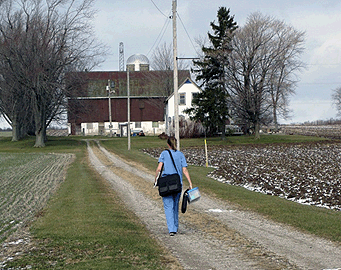
Figure 1: Autonomy.
In addition, some students noted that, due to a low number of healthcare professionals and diverse clientele in rural settings, a generalist role is required, and that nurses who feel comfortable and enjoy generalist practice might find that rural nursing appeals to them. A participant noted:
The generalist role demands that rural nurses be creative and practice proficiently in multiple areas...nurses who strive for a challenge and seek constant professional stimulation will more likely embrace the generalist role...in rural nursing.
Participants in this study also perceived that rural areas often foster a strong sense of community, and that nurses practicing in these areas may experience belonging and connectedness within the community that supports their practice. A participant wrote:
A responsive relationship and connection to the rural community enable rural RNs to be successful, because they are seen as valued and trusted members of the community.
Figure 2 illustrates a participant's perspective regarding this type of trusting collaborative relationship.
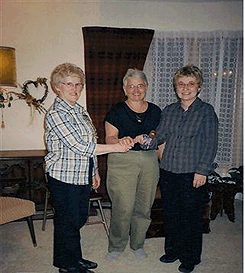
Figure 2: An opportunity to learn.
In addition, the slower pace of life in rural communities compared with urban communities was noted as resulting in less stress and this could be a source of restoration for nurses. A participant commented:
Remote areas are less contaminated by...garbage...you'll be in awe of the power and beauty of nature.
Figure 3 depicts a participant's appreciation for the rural context.
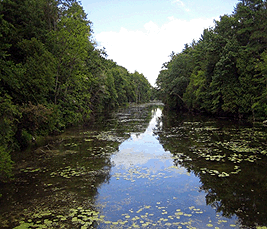
Figure 3: Beauty of nature.
Challenges to rural nursing practice
Some study participants noted that nursing education often does not adequately prepare students for the rural nurse role. Accordingly, several participants suggested that additional rural education in nursing programs would help to increase students' awareness, confidence, and comfort with rural practice. Study participants also believed that enhanced rural education in nursing programs would help them feel more prepared for the generalist role, the range of responsibilities, and the autonomous practice experienced by rural nurses.
In addition, participants noted that professional isolation characterizes nursing in rural settings, and that rural nurses often have few opportunities for professional development, due to distance, weather, and staffing issues, as this comment reveals:
Due to isolation, [nurses experience] limited access to continuing education, interaction with healthcare professionals, and resources to provide care.
Safety issues were also highlighted as participants noted that rural nurses risk their well-being by travelling through remote areas to provide care for patients, often on a daily basis. A participant commented:
Because of the safety issues that are present in winter driving, this forces the nurse to put her safety on the line for the care of others.
Figure 4 aptly reveals common safety and isolation issues - weather and road conditions - for rural nurses.
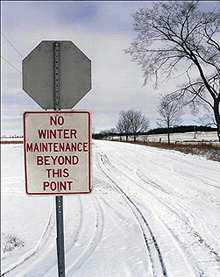
Figure 4: How do I get there?
Participants also noted that the lack of anonymity in a small community where everyone knows everyone can result in a blurring of the boundaries between personal and professional life, and that this can act as a barrier to rural nursing. A student explained:
Because of the small populations and the limited amount of health professionals in rural areas, visibility and unique connections with clients create challenges for rural nurses... for example confidentiality and burnout.In addition, participants suggested that a nurse's status as an insider or an outsider in the community can affect interactions, acceptance, and effectiveness. A student stated:
The close-knit culture found within rural communities can often make it difficult for new residents to be accepted, as they may be viewed as strangers or outsiders.
These reflections regarding insider/outsider reflect similar knowledge in the literature, notably in Lee27.
As a consequence, some participants noted that it was particularly important that:
Nurses...self-reflect on their values and beliefs so they are less likely to project [them] onto the community.
Figure 5 reveals the nature of some of the diversity in rural communities and invites reflection upon values that accompany cultural diversity.
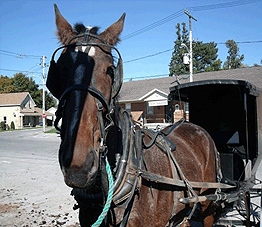
Figure 5: The path less travelled.
Discussion
The pictorial and reflective data in this study provide helpful insights into the understanding and perspectives that nursing and health sciences students may hold regarding rural nursing. As such, this information is important for nursing education programs across the country in their facilitation of nursing and interprofessional/interdisciplinary student understanding and expertise regarding rural nursing practice. With enhanced understanding about rural health and rural nursing, students from diverse disciplines may feel more confident to select nursing education programs, and nursing students may be more inclined to select rural nursing practice positions post-graduation. Both groups would be better prepared for rural practice following graduation, thereby helping to provide needed health care in underserved rural settings. Indeed, in this study, as their photovoice experiences progressed, students with both nursing and health sciences, as well as urban and rural backgrounds, increasingly commented on the value of the photovoice assignment in facilitating their understanding of rural situations and rural nursing, and their enhanced interest in selecting a rural practice location. Students also recommended that this rural course, or a similar rural course, be mandatory for all nursing students.
Themes revealed in the study provide important data for clarification and elaboration in subsequent classes and courses. For example, some practice characteristics noted as facilitators, such as autonomy and the generalist role, may in fact represent both a challenge and a facilitator; further elaboration could facilitate understanding of ways and reasons for these contrasting interpretations, and would help students better understand the complex nature of rural nursing practice and the rural context. In addition, assumptions and generalizations, as revealed by some of the photos and written reflections, could be further elaborated and critiqued for their significance regarding rural nursing practice. For example, students' assumptions that a strong sense of community and less stress characterize rural contexts and positively affect rural nursing practice may be departure points for discussion of how one may practice in rural settings that do not display these characteristics.
The high quality of the photos and the insightful reflections in this study reveal students' creativity and interest in portraying ideas regarding rural nursing in this photovoice project. In addition, students were keen to share and discuss their pictures and reflections during the course. Thus, it would seem that photovoice can be a useful educational (as well as research) strategy in fostering interest and learning about rural nursing practice. The implications may well be students who are more appreciative, informed, prepared, and interested in selecting and remaining in rural nursing positions post-graduation. For those students who choose to remain in an urban practice setting, it is likely that they will be better able to support rural patients with more effective and relevant teaching, discharge planning, referral, and follow up.
Limitations
Although the photovoice method was useful, when used during a formal university classroom course with explicit time requirements, the distances, and thus the nature of the rural locations to which students can travel, can be somewhat limited. For example, students tended to select rural communities that were close to the urban location of their residences. To enhance understanding of more isolated rural settings, photovoice could be used in clinical and other courses where students may be residing in more distant locations, such as in northern and very rural and remote settings. In addition, students must be sensitized to the fact that all may not be as it appears in a photograph, that continuous reflection, consideration of complexity, and life and professional experience and knowledge, together with adequate supports, are needed to accurately understand and effectively work in complex rural contexts.
Recommendations
To enrich the use of photovoice in future educational and research endeavors, the following suggestions are offered:
- Students engage in a group photovoice experience whereby two or more students take photographs and prepare reflections collectively. This would foster dialogue, critique, and discussion that could advance critical thinking and reflection about rural health, rural contexts, and rural practice situations.
- Other aspects for which photovoice could be useful in terms of research and education that advance understanding of rural health and rural practice:
- The experience of being a client in a rural healthcare situation (home, clinic, hospital, school, community).
- The experience of a nurse or other healthcare professional in a rural healthcare situation.
- Analysis of health promotion/prevention strategies that may be useful/not useful in rural settings.
- How the rural environment (physical, social, economic etc) impacts life and health in rural communities.
- Exploration of illnesses, injuries, and conditions commonly seen in the rural setting.
This study provides a beginning point for discussing the use of photovoice as a rural education strategy. Indeed, this research has revealed that photovoice can be a useful educational approach in helping students appreciate, reflect upon, and understand rural practice issues and contexts, content that is frequently difficult for students to grasp.
However, for an autonomous professional practice as complex and demanding as rural nursing, clearly more than one (elective) rural course is needed in undergraduate nursing programs. As revealed in this research, the use of photovoice in other rural courses would also likely be worthwhile in advancing effective attitudes, knowledge, and experiences that would benefit rural nursing and other rural health professional practice in rural communities. By requiring students of urban and rural backgrounds to venture into rural settings and reflect on what they observe there, photovoice can help to advance understanding about both the theoretical and practical aspects of rural practice.
References
1. Canadian Institute for Health Information. How healthy are rural Canadians? An assessment of their health status and health determinants. Ottawa, ON: CIHI, 2006.
2. Leipert B. Rural women's health issues in Canada: an overview and implications for policy and research. Canadian Woman Studies 2005; 24(4): 109-116.
3. Kulig J, Williams A. (Eds.) Health in rural Canada. Vancouver, BC: UBC Press, 2012.
4. Health Canada. Canada's aging population. Ottawa, ON: Minister of Public Works and Government Services Canada, 2002.
5. Joint Task Group on Public Health Human Resources. Building the public health workforce for the 21st century. (Online) 2005. Available http://www.phac-aspc.gc.ca/php-psp/pphw-eng.php (Accessed 10 September 2011).
6. Canadian Public Health Association. Public health - community health nursing practice in Canada: roles and activities, 4th edn. Ottawa, ON: CPHA, 2010.
7. Community Health Nurses of Canada. A synthesis of Canadian community health nursing reports. (Online) 2010. Available: http://www.chnc.ca/nursing-publications.cfm (Accessed 8 November 2011).
8. Winters C, Lee H (Eds). Rural nursing: concepts, theory, and practice, 3rd edn. New York: Springer, 2010.
9. Leipert B, Reutter L. Women's health and community health nursing practice in geographically isolated settings: A Canadian perspective. Health Care for Women International 1998; 19: 575-588.
10. Bigbee J. The uniqueness of rural nursing. Nursing Clinics of North America 1993; 28(1): 131-144.
11. Molinari D, Bushy B (Eds). Rural nursing: Transition to practice. New York: Springer, 2012.
12. Ministry of Health and Long Term Care. Rural and northern health care report: executive summary. (Online) 2010. Available: http://www.health.gov.on.ca/en/public/programs/ruralnorthern/docs/exec_summary_rural_northern_EN.pdf (Accessed 21 September 2011).
13. Stewart N, D'Arcy C, Pitblado R, Morgan D, Forbes D, Remus GM et al. A profile of registered nurses in rural and remote Canada. Canadian Journal of Nursing Research 2005; 37(1): 122-145.
14. Kulig J, Macleod M, Stewart N, Pitblado R. Rural health. In: L Stamler, L Yiu (Eds). Community health nursing: a Canadian perspective. Toronto, ON: Pearson, 2012; 363-374.
15. Bushy A, Leipert B. Factors that influence students in choosing rural nursing practice: A pilot study. Rural and Remote Health 5: 387. (Online) 2005. Available: www.rrh.org.au (Accessed 2 May 2012).
16. Ministry of Health and Long Term Care. Rural and northern health care report: recommendations. (Online) 2010. Available: http://www.health.gov.on.ca/en/public/programs/ruralnorthern/docs/recommendations_rural_northern_EN.pdf (Accessed 21 September 2011).
17. Ministry of Health and Long Term Care. 2009 Annual report of the chief medical officer of health of Ontario to the legislative assembly of Ontario. (Online) 2011. Available: http://news.ontario.ca/mohltc/en/2011/01/2009-annual-report-of-the-chief-medical-officer-of-health-of-ontario-to-the-legislative-assembly-of.html (Accessed 22 October 2011).
18. Ministry of Health and Long Term Care. Rural and northern health care report: Executive summary. (Online) 2010. Available: at:http://www.health.gov.on.ca/en/public/programs/ruralnorthern/docs/exec_summary_rural_northern_EN.pdf (Accessed 21 September 2011).
19. Brookfield S. The power of critical theory: liberating adult learning and teaching. San Francisco, CA: Jossey-Bass, 2005.
20. Kolb D. Experiential learning: experience as the source of learning and development. New Jersey: Prentice-Hall, 1984.
21. Wang C, Burris M, Ping X. Chinese village women as visual anthropologists: A participatory approach to reaching policy makers. Social Science and Medicine 1996; 42: 1391-1400.
22. Leipert B. Rural and remote women and resilience: grounded theory and photovoice variations on a theme. In: C Winters, H Lee (Eds). Rural nursing: concepts, theory, and practice, 3rd edn. New York: Springer 2010; 105-129.
23. Wang D, Burris M. Photovoice: concept, methodology, and use for participatory needs assessment. Health Education and Behavior 1997; 24: 369-387.
24. Patton M. Qualitative research & evaluation methods, 3rd edn. London, UK: Sage, 2002.
25. Oliffe J, Bottorff J, Kelly M, Halpin M. Analyzing participant produced photographs from an ethnographic study of fatherhood and smoking. Research in Nursing & Health. (Online) 2008. Available: www.interscience.wiley.com (Accessed 14 July 2011).
26. Graneheim U, Lundman B. Qualitative content analysis in nursing research: concepts, procedures, and measures to achieve trustworthiness. Nurses Education Today 2004; 24: 105-112.
27. Lee H. Conceptual basis for rural nursing. New York: Springer, 1998.

